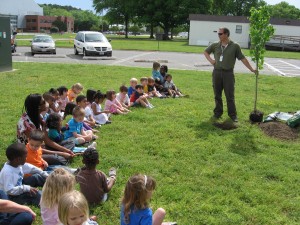 Trees play a vital role in the beauty of the Center and the health of the ecosystems that many wildlife and birds depend on for survival. The principal objective of forest management and urban forestry management at LaRC is to maintain and enhance the ecological integrity of forested landscapes while supporting the Center’s mission. Under the principles of ecosystem management, forest treatments may be used to achieve Center goals for forest enhancement and restoration, wildlife habitat improvement, wildfire protection, recreational development, training requirements, and safety compliance. The LaRC Environmental Office has the responsibility of determining if forest treatments (including the removal of any trees) are necessary.
Trees play a vital role in the beauty of the Center and the health of the ecosystems that many wildlife and birds depend on for survival. The principal objective of forest management and urban forestry management at LaRC is to maintain and enhance the ecological integrity of forested landscapes while supporting the Center’s mission. Under the principles of ecosystem management, forest treatments may be used to achieve Center goals for forest enhancement and restoration, wildlife habitat improvement, wildfire protection, recreational development, training requirements, and safety compliance. The LaRC Environmental Office has the responsibility of determining if forest treatments (including the removal of any trees) are necessary.
LaRC’s tree management goals include the following:
• Conserve and enhance the health and integrity of existing trees that contribute to overall ecosystem function
• Maintain a diversity of natural trees that support a full complement of native wildlife species
• Provide an attractive, well-maintained working environment for facility personnel through the proper management and enhancement of landscaped areas
• Enhance landscaped areas to better contribute to overall ecosystem function; and
• Increase forested acreage through reforestation where practicable, within the constraints of LaRC’s mission.
• Maintain LaRC Tree City USA certification.
In March 2014, Students from Virginia Western, Thomas Nelson, and Dadney S. Lancaster Community Colleges completed a trial service learning project at NASA Langley Research Center as part of a distance learning GIS class. The innovative cross discipline class was instructed by distance means from an instructor at Tncc , delivered by Vwcc and content provided by faculty at all three community colleges. Students from both geospatial and forestry programs participated in the cross discipline exercise learning and teaching each other during the completion of the project. The course culminated in a three day field trip to NASA Langley where nine students completed an urban forest tree survey. The cross discipline course required groups of students to operate commercial grade gps units, identify over 30 different tree species, collect industry standard measurements of over 300? individual trees, and create maps of the tree locations. Students also completed analysis of the collected data to provide maps of problem tree locations, species concentration and relative tree size.
A bonus for the project was the measurement of two trees for entry into the Virginia Big Tree program. Preliminary estimates are that the sassafras tree they measured will be the number two tree on the list and the white oak will fall within the top ten trees statewide. The participating community college partners intend to repeat the class and expand it to all of the 23 Virginia community colleges.



